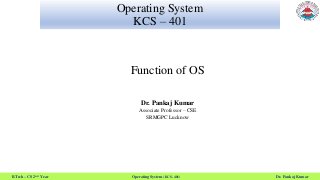
Function of Operating System
- 1. B.Tech – CS 2nd Year Operating System (KCS- 401) Dr. Pankaj Kumar Operating System KCS – 401 Function of OS Dr. Pankaj Kumar Associate Professor – CSE SRMGPC Lucknow
- 2. Outline of the Lecture B.Tech – CS 2nd Year Operating System (KCS- 401) Dr. Pankaj Kumar Function of Operating System Feature of Operating System Advantage of OS Disadvantage of OS
- 3. Function of OS B.Tech – CS 2nd Year Operating System (KCS- 401) Dr. Pankaj Kumar
- 4. Function of OS B.Tech – CS 2nd Year Operating System (KCS- 401) Dr. Pankaj Kumar • Process management:- Process management helps OS to create and delete processes. It also provides mechanisms for synchronization and communication among processes. • Memory management:- Memory management module performs the task of allocation and de-allocation of memory space to programs in need of this resources. • File management:- It manages all the file-related activities such as organization storage, retrieval, naming, sharing, and protection of files.
- 5. Function of OS B.Tech – CS 2nd Year Operating System (KCS- 401) Dr. Pankaj Kumar • Device Management: Device management keeps tracks of all devices. This module also responsible for this task is known as the I/O controller. It also performs the task of allocation and de-allocation of the devices. • I/O System Management: One of the main objects of any OS is to hide the peculiarities of that hardware devices from the user. • Secondary-Storage Management: Systems have several levels of storage which includes primary storage, secondary storage, and cache storage. Instructions and data must be stored in primary storage or cache so that a running program can reference it.
- 6. Function of OS B.Tech – CS 2nd Year Operating System (KCS- 401) Dr. Pankaj Kumar • Security:- Security module protects the data and information of a computer system against malware threat and authorized access. • Command interpretation: This module is interpreting commands given by the and acting system resources to process that commands. • Networking: A distributed system is a group of processors which do not share memory, hardware devices, or a clock. The processors communicate with one another through the network. • Job accounting: Keeping track of time & resource used by various job and users. • Communication management: Coordination and assignment of compilers, interpreters, and another software resource of the various users of the computer systems.
- 7. Feature of OS B.Tech – CS 2nd Year Operating System (KCS- 401) Dr. Pankaj Kumar • Protected and supervisor mode • Allows disk access and file systems Device drivers Networking Security • Program Execution • Memory management Virtual Memory Multitasking • Handling I/O operations • Manipulation of the file system • Error Detection and handling • Resource allocation • Information and Resource Protection
- 8. Advantage of OS B.Tech – CS 2nd Year Operating System (KCS- 401) Dr. Pankaj Kumar • Allows you to hide details of hardware by creating an abstraction • Easy to use with a GUI • Offers an environment in which a user may execute programs/applications • The operating system must make sure that the computer system convenient to use • Operating System acts as an intermediary among applications and the hardware components • It provides the computer system resources with easy to use format • Acts as an intermediator between all hardware's and software's of the system
- 9. Disadvantage of OS B.Tech – CS 2nd Year Operating System (KCS- 401) Dr. Pankaj Kumar • If any issue occurs in OS, you may lose all the contents which have been stored in your system • Operating system's software is quite expensive for small size organization which adds burden on them. Example Windows • It is never entirely secure as a threat can occur at any time
- 10. Queries ??????? B.Tech – CS 2nd Year Operating System (KCS- 401) Dr. Pankaj Kumar
